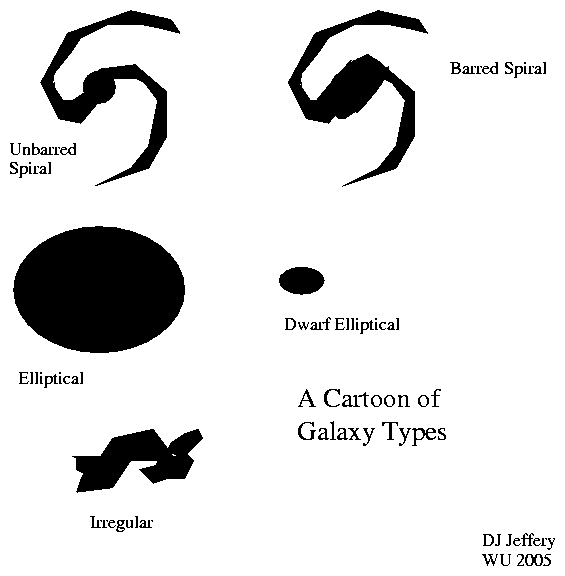
Caption: A cartoon of the 3 main galaxy types of the Hubble sequence (of galaxy types) which is the most usual/traditional galaxy classification scheme.
Features:
- The 3 main
galaxy types are
spiral galaxies
(which have galaxy disks
and spiral arms),
elliptical galaxies
(which are just swarm of stars with relatively random
orbital orientations),
and
irregulars
(which, oddly enough, are irregular in structure).
- Frequency of Galaxy Types: NOT counting some unknown number of dwarf galaxies????, we have in the local universe the estimated distribution:
- ellipticals ∼ 20 %.
- spiral galaxies ∼ 77 %.
- Irregular galaxies ∼ 3 %.
- Reference: FK-582.
Note, we are using the expression local universe vaguely here since yours truly has NOT tracked down exactly what the reference FK-582 uses for local universe. One can't do everything---sometimes there's A Bridge too Far (1974).
For a discussion of the meaning of local universe, see Specifying the Local Universe Vaguely and Precisely.
- The spiral galaxies are divided into unbarred spiral galaxies (which have NO galactic bars in their galactic bulges), barred spirals (which have galactic bars in their galactic bulges), and intermediate spiral galaxies (which are in between the other two kinds of spiral galaxies).
In fact, the 3 subtypes are just ideal cases along a continuum from zero galactic bar to large galactic bar. If one says spiral galaxies without qualification one can mean either unbarred spiral galaxies or spiral galaxies with any degree of galactic bar. Context must decide the meaning.
Actually, galaxies with galactic bars are best since you can get a drink.
- The cartoon just shows a dwarf elliptical galaxy, but there are other kinds of dwarf galaxies. There is NO universal rule on upper size limit on dwarf galaxies, but one authority's rule is dwarf galaxies have mass in stars M_* ⪅ 10**9 M_☉ (Ci-54). Using this rule, their total mass (the sum of mass in stars and dark matter) M ⪅ 10**11 M_☉ (Ci-55).
For comparison, consider the non-dwarf galaxy the Milky Way (M_* ∼ 5*10**10 M_☉, 10**12 M_☉: estimates c.2025) (Wikipedia: Milky Way: Mass).
- Actually, there are many, many galaxy types galaxies and often galaxies fall into more than type. For a NOT exhaustive list of galaxy types, see Galaxies file: galaxy_types.html.
- Frequency of Galaxy Types: NOT counting some unknown number of dwarf galaxies????, we have in the local universe the estimated distribution:
Local file: local link: galaxy_types_main.html.
File: Galaxies file: galaxy_types_main.html.